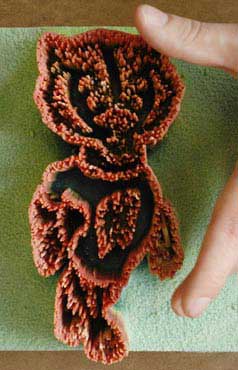| Posted: March 27, 2007 |
Unique models help teach nanoscience to the blind |
|
(Nanowerk News) At the root of scientific study are observations made with the eyes; yet in nanoscience, our eyes fail us.
|
|
The smallest object we can see still looms thousands of times larger than a typical nano-sized structure. Even the most powerful microscopes can't peer into the nanoscale directly.
|
|
That's why nanoscale experiments offer such great opportunities to teach blind and visually impaired students about science and pique their interest in the field, says Andrew Greenberg, education and outreach coordinator for the University of Wisconsin-Madison Nanoscale Science and Engineering Center (NSEC) and the Institute for Chemical Education.
|
|
"The fact is, we're all blind at the nanoscale," he says. "So the message to blind students is, 'This is something you can do, this is a field you can enter. You have the ability to understand what's going on at the nanoscale just as much as anyone else.'"
|
|
To give blind students a feel - literally - for nanoscience and technology, Greenberg and Mohammed Farhoud, a senior biochemistry student working with UW-Madison Center for Biology Education (CBE) Director Dave Evans, are building three-dimensional models of nano-surfaces that are large enough to be explored with the hands. Their first attempt replicates "NanoBucky," a nanoscale version of the UW-Madison mascot, Bucky Badger, made entirely from tiny carbon nanofiber "hairs."
|
 |
An enlarged, 3-D model of "NanoBucky," a nanoscale version of Bucky Badger made entirely from tiny carbon nanofiber "hairs." To create the 3-D model, Mohammed Farhoud, a senior in biochemistry, converted the 2-D information contained in a scanning electron microscopy image of the original NanoBucky into 3-D, and then used these data to "print" the model in plaster with an engineering tool known as a rapid prototyping printer. The 3-D version is tens of thousands of times larger than the original NanoBucky -- 9,000 of which can fit on the head of a pin -- but still faithfully replicates the nanofibers composing the nano-mascot's structure. (Image: University of Wisconsin-Madison)
|
|
Greenberg and Farhoud are presenting the work, funded by the National Science Foundation, on March 27 at the 233rd National Meeting of the American Chemical Society.
|
|
Created by UW-Madison chemistry professor Bob Hamers to demonstrate a method for controlling the growth of nanomaterials, the original NanoBucky is so tiny that approximately 9,000 of him can fit on the head of the pin. Though Greenberg and Farhoud's plaster 3-D models are several inches long and tens of thousands of times larger, they aim to faithfully reproduce every last nanofiber of Bucky's being.
|
|
"We want to get across that NanoBucky is made up of individual carbon nanofibers standing on end," says Greenberg. "If the students' fingers were small enough, this is what a surface would feel like at the nanoscale."
|
|
The pair is still perfecting the modeling method, which employs an engineering tool called rapid prototyping. But eventually, Greenberg plans to test whether the models help blind students grasp nanoscience concepts, especially the complex ways in which data are collected to produce 2-D images of nanoscale surfaces.
|
|
He also wonders whether 3-D models might help sighted students - or the public, for that matter - also appreciate the nanoscale. "A two-dimensional image is great," he says. "But if you can touch something - everyone enjoys that." Greenberg first conceived of the models during a visit to the Indiana School for the Blind, where a colleague showed him 3-D models of molecules that blind students handled to learn chemical structures. Soon afterward, he contacted Farhoud, master of the rapid prototyping printer in the UW's Biology New Media Center. To help professors convey difficult concepts in the classroom, Farhoud routinely builds 3-D models from computer-generated images of tiny things, including molecules and cellular structures.
|
|
NanoBucky, though, was on a scale all his own. Starting with a 2-D, grey-scale picture of the nano-mascot taken with scanning electron microscopy (SEM), Farhoud first reversed the image, making the blacks appear white and vice versa. Next, he used the various shades of grey in the image to confer heights on the carbon nanofibers: the blackest black was assigned a maximum height, white got a value of zero, and the computing program MATLAB calculated all the values in between.
|
|
Farhoud then sent these newly acquired 3-D data into the rapid prototyper, which lays down plaster layer-by-layer to "print" 3-D models.
|
|
Greenberg and Farhoud are confident they can construct models from data generated by other common tools of the nanotechnology trade, such as atomic force microscopy (AFM). In fact, AFM output has proven easier to work with than SEM images, says Farhoud, because the data are already 3-D. They also plan to replicate other nanoscale surfaces, such as those made from materials called block copolymers.
|
|
Besides being fun to touch and handle, Greenberg hopes the models will encourage more blind and visually impaired students to pursue science, technology and engineering. Because current learning and research tools don't allow them to experience science on their own, many blind students don't consider science an attractive career choice.
|
|
"One of the goals of our program is to build diversity into science and engineering," he says. "We really want to open these careers to anyone who is interested."
|

